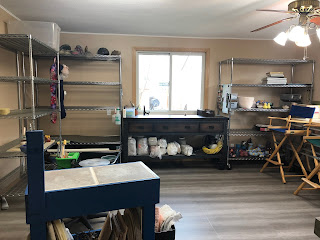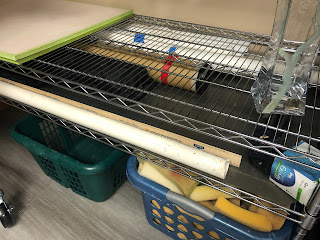 |
| My cleaned and remodeled studio as viewed from (nearly) the doorway to the house. |
I've finally finished my studio move-in. I've got everything (or, very nearly everything) cleaned and put away. Furniture has been replaced and is where I want it. Drawers and shelves are organized and lots of random papers, tools, etc have been cleared out. I could actually use this space now, if I weren't, like, writing a blog post about it instead.
My husband says I'm ahead of schedule; he didn't expect me to have the studio ready until May. When he first finished the remodel, we brought about half my stuff into the studio from storage and left me to clean it, organize it, and put it away. Last Sunday I spent hours and hours working on it. I had paced myself a bit the weekend before.
The cupboards were very dusty. I have removed and cleaned everything in the bottom and the far right cabinet, but I haven't finished cleaning the top of the middle and left cupboards--where it is difficult to reach and I don't use stuff very often.
Everything needed to be cleaned because everything got dusty. When my husband prepared the floor, he ground off the glue and that was a very dusty process. Everything that stayed in the studio cupboards was covered in a fairly thick layer of dust, even though the cupboards were shut at all times. Luckily the drawers stayed fairly clean.
 |
| The open shelves on the right area clean and organized. The main and lower shelves have some fountains I am planning to test and maybe sell at YVC's clay sale in April. |
Everything that was stored downstairs was also coated in dust. While sanding, Sean obviously had the door shut, but we didn't realize until he had been sanding for about 20 minutes that the dust was shooting out through the gap under the door. We plugged it up right away, but the dusty damage was done.
The new metal shelves are much deeper than the older shelves. This is a more logical use of space, at least when the space is organized. The drawers of the metal workbench contain sprigs, stamps, brushes, tools, paint, and molds, all cleaned and organized.
At first, when bring stuff in, we piled all the sculpture, large and small, on the new metal shelves on the right side of the room. I brought in a bin of water and washed every piece, every tool, every sprig, and basically every item that stayed in the studio. The shelves on the left side of the room had towels laid out so everything could dry, but it still took days.
 |
| One of four boxes of stuff I threw away during this process. I probably had another two bags of trash besides the stuff I donated, stored elsewhere, or sold. |
I also tried to eliminate as much junk as I could from the studio. When I moved stuff in originally, in 2007, we were moving our whole house and we were distracted with new jobs, a new city, a whole new house, and fairly soon a new baby, so there was less intentional organization in the studio. Over the years things both useful and less-so have accumulated in the space. I threw away some old and broken sculpture as well as broken tools and storage containers, sprigs that didn't really work and random junk. I donated duplicate tools to the YVC clay studio and handed down a number of brushes to my daughter.
I also didn't let the old shelves stay in the studio. I had three types of shelves in the old studio. The actual bookcases are now installed in the guest room and in the stairway landing of the house. The two sets of wooden shelves that are easy to set up and take apart are in pieces in the lean-to where they can be used for art shows if needed. The plastic and laminate shelves that also used to be used for art shows were already in bad shape. They wobbled and had to be used upside down because one of the feet was broken off. I donated them to some neighborhood kids who were collecting stuff for a yard sale last weekend.
 |
| The main studio work table, wheel, and storage for works in progress. Old work I can't bear to part with (but probably won't sell) is on the top shelf. |
Now that everything is clean and dry and I've eliminated a sizable amount of extraneous stuff, I have a fairly good idea of workflow in the studio. It isn't much different than before, but there is a lot more space for storing works in progress in the studio and there is less floorspace devoted to storing stuff that doesn't belong in the studio (including kids art stuff and a basket of yard toys).
 |
| The bottom shelf has photography equipment (backdrop, backdrop support and tripod) as well as a PVC pipe for a rolling pin and my installation grid for my wall bulbs. |
In front of the east window is my main work space with clay storage underneath, a high worktable and my main tools in the deep drawer on the left. To the left of the work table and surrounding the wheel is work-in-progress storage. On the floor are two baskets of foam for building on or for supporting or transporting work in progress. The foam also works well as a lure for studio cats if it is placed in front of the window. I used to have lots of boxes and packing material kept under the work tables, but this has been moved into the lean-to on the side of the room (or removed from our possession by a slightly more ruthless cleaner than myself).
 |
| The blue door leads to the lean-to, the light door to the house. The wedging table and extruder match. To the right is clay recycling. |
Behind the wheel is Bludolph, my wedging table, with ware boards, bats, and my Giffin Grip and tools. In keeping with the new organized and clean set-up, I made myself a Giffin Grip rack out of some scrap wood left over from a project in grad school (because we don't throw things away in my family). The tool rack replaces a perpetually dirty cup on a shelf next to the wheel.
 |
| My homemade rack for my Giffin Grip tools. |
I used to keep both clay and ware boards under the wedging table. Clay storage was basically a pile in a bucket next to the wedging table. Bookshelves made this whole area difficult to access. The new set up leaves lots of open space next to the wheel. I've put two recycle buckets here, one for red and one for grey clay.
 |
| Clay recycling. Now that I look at it this way I am disappointed that I put the red clay in the grey bucket and the grey clay in the orange bucket. Missed opportunity. |
To the right of the central work table I have shelves for glazed work above and shelves for fired pieces below. These pieces are designed to be put together with other ceramic pieces and non-ceramic elements in order to become a finished sculpture. Some of them are ready to be put together, others need some work.
 |
| The blue pieces are all meant to be a set, but the physics wasn't working well for me last time I tried to put them together. Maybe now I'll have some time to problem solve. |
 |
| One of my four inspiration pages, including sketches of my own, old work of my own, and artists' cards. |
































